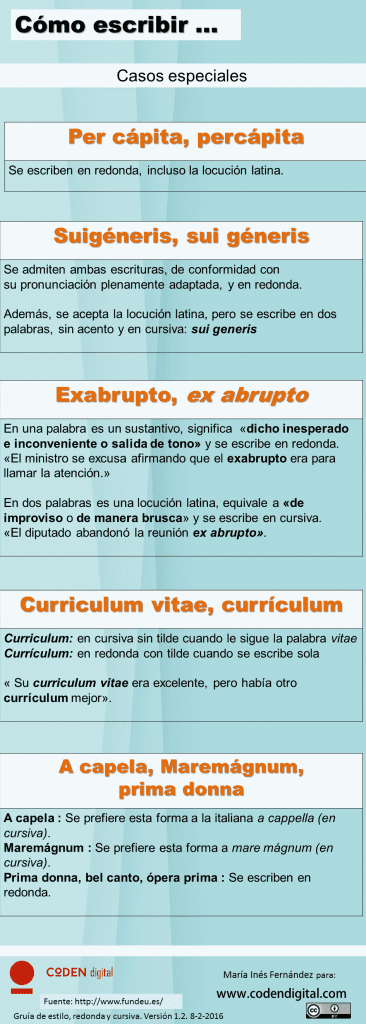Contenidos
Curriculum con o sin tilde
How to type resume with accent in gmail
In the media it is common to find phrases such as “The opposition has asked for a review of the counselor’s resume”, “Writing a resume can be one of the most complex tasks” or “Your resume should be concise, not seem overloaded with information”.
Although the “Diccionario panhispánico de dudas” (2005) established the use of the accent in this locution, the current Ortografía (2010) has modified this criterion and advocates writing Latin locutions in italics (or between quotation marks if this type of letter is not available) and without accent, so that the appropriate in the previous examples would have been “curriculum vitae”.
In this locution, the common pronunciation of the second element is /bíte/, typical of Vulgar Latin, although /bítae/, corresponding to Classical Latin, is also used. On the other hand, the pronunciation /bitáe/ is not appropriate.
The plurals of “currículo” and “currículum” are “currículos” and “currículums”, respectively; that of the locution, however, is invariable and has masculine gender: “los curriculum vitae”. The variant “currícula” is considered inappropriate.
Cómo se escribe el currículum para un trabajo
Con todas las regiones del mundo que utilizan el inglés, y todas las palabras tomadas de otros idiomas, la ortografía inglesa es ciertamente problemática. A menudo hay más de una ortografía aceptable para una palabra. El equipo de ESL-Library se enfrentó recientemente a una controversia sobre la ortografía de “resume”. Esta palabra, que proviene del sustantivo francés “résumé”, aparece muchas veces en nuestras lecciones de Office Life – Business in English, así como en algunas lecciones dentro de la sección Everyday Idioms (Part 2) y en la lección de Employment en nuestra sección Living in English . Habíamos deletreado “resume” sin ningún acento, pero tuvimos que tomar una decisión sobre si queríamos seguir deletreándolo así. A continuación compartimos nuestro proceso de reflexión, y nos encantaría saber qué piensan otros profesores.
Nuestro consenso fue que el contexto es suficiente para determinar si “resume” se refiere al sustantivo (CV) o al verbo (volver a empezar). El sustantivo se utiliza principalmente en contextos de inglés comercial cuando se habla de búsqueda de empleo, solicitud de trabajo, entrevistas, etc. Los alumnos deben aprender a utilizar el contexto para averiguar el significado de las palabras; es una habilidad esencial. Palabras como wind (sustantivo) / wind (verbo) y present (sustantivo) / present (verbo) no suelen plantear problemas porque el contexto suele aclarar qué significado/parte de la oración se está utilizando.
Revisión ortográfica del currículum
P: ¿Está el sustantivo “résumé” (la lista de logros de alguien) tan arraigado en el inglés que ya no son necesarias las tildes? La única razón que veo para mantenerlos es que el sustantivo no se confunda con el verbo “resume” (que significa volver a empezar tras una interrupción).
R: El documento que presume de los logros de uno puede escribirse en inglés con o sin tildes, según el manual de estilo o el diccionario que sirva de guía. Pero las grafías más comunes parecen utilizar al menos un acento. (En francés, la palabra se escribe con acentos agudos sobre las dos e).
El Merriam-Webster’s Collegiate Dictionary (11ª edición) recoge las grafías en este orden: “résumé” o “resume”, también “resumé”. (La redacción indica que las dos primeras tienen la misma popularidad, y la tercera es algo menos común).
El American Heritage Dictionary of the English Language (4ª ed.) recoge las mismas grafías, pero en orden inverso: “resumé” o “resume” o “résumé”. (La redacción indica que las tres son igualmente populares).
Resume or resume
In the media it is common to find phrases such as “The opposition has asked for a review of the counselor’s curriculum vitae”, “Writing a curriculum vitae can be one of the most complex tasks” or “Your curriculum vitae should be concise, not seem overloaded with information”.
Although the Diccionario panhispánico de dudas (2005) established the use of the accent in this locution, the current Ortografía (2010) has modified this criterion and advocates writing Latin locutions in italics and without the accent, so that what is appropriate in the previous examples would have been curriculum vitae.
In this locution, the current pronunciation of the second element is /bíte/, typical of Vulgar Latin, although /bítae/, corresponding to Classical Latin, is also used. On the other hand, the pronunciation /bitáe/ is not appropriate.
The plurals of currículo and currículum are currículos and currículums, respectively; that of the locution, however, is invariable and has masculine gender: los curriculum vitae. The variant currícula is considered inadequate.
